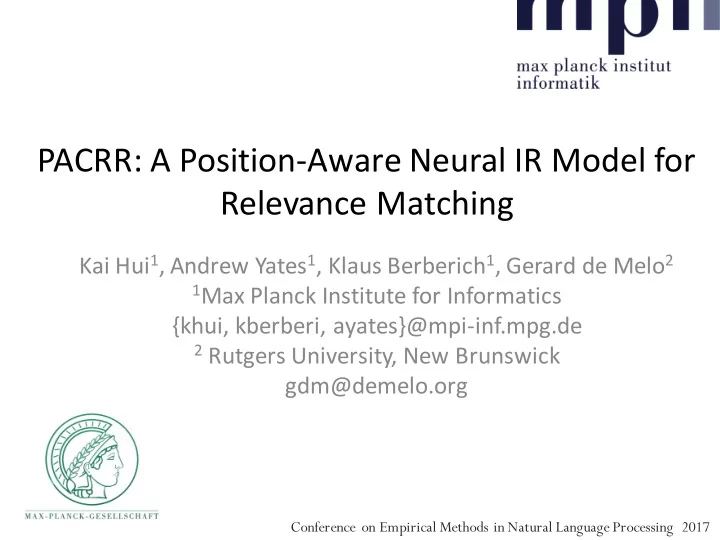

PACRR: A Position-Aware Neural IR Model for Relevance Matching Kai Hui 1 , Andrew Yates 1 , Klaus Berberich 1 , Gerard de Melo 2 1 Max Planck Institute for Informatics {khui, kberberi, ayates}@mpi-inf.mpg.de 2 Rutgers University, New Brunswick gdm@demelo.org Conference on Empirical Methods in Natural Language Processing 2017
Motivation q Decades of research in ad-hoc retrieval provides useful measures to boost the performance q Unigram matching signals have been successfully incorporated in neural IR models [2,4] q How to incorporate positional matching information remains unclear 2
Matching Information to Incorporate QUERY computer science course Denmark DOCUMENT 1. Institutes in Denmark provide graduate-level courses in computer science. 2. PCHandle is an online portal for purchasing personal computers in Denmark. § Unigram matching: matching individual terms independently § Term dependency: “computer science” § Query proximity: the proximity between different matchings 3
Model Unigram Matching by Counting § Given a query Q and a document D § Compute the semantic similarity between each term pair, where one term is from Q and another is from D (via word2vec) § Group such similarity into bins and model the relevance between Q and D with a histogram [2] computer science Rel(Q, D) course Denmark bag-of-word assumption (independence among terms) 4
Beyond Unigram Matching: Model Positional Information 1) Retain the similarity into the similarity matrix, keeping both similarity and their relative positions [1,3,5] computer science course Denmark 5
Beyond Unigram Matching: Model Positional Information computer computer computer science science science course course course 2) Matching could be modeled based on different local patterns in the similarity matrix 3) Individual text windows only include one salient matching pattern 6
Beyond Unigram Matching: Model Positional Information computer science course Denmark 4) Only retain the salient matching signals for individual query terms 7
PACRR: Position-Aware Convolutional Recurrent Relevance Matching (3) K-max pooling: retain the k (1) CNN layers with different most salient signals for each query sizes: 2X2, 3X3, 4X4, etc.. term (2) Max-pooling among (4) LSTM layer for combination filters 8
PACRR: Position-Aware Convolutional Recurrent Relevance Matching § CNN kernels (dozens of filters) in different sizes, corresponding to text windows with different length computer science, science course, etc.. computer science course, science course Denmark, etc.. 9
PACRR: Position-Aware Convolutional Recurrent Relevance Matching § Max pooling different filters for individual kernels (individual text windows at most include one matching pattern) 10
PACRR: Position-Aware Convolutional Recurrent Relevance Matching § K-max pooling for individual query terms, retaining the k most salient signals for individual query terms K=2, 2X2 kernel K=2, 3X3 kernel 11
PACRR: Position-Aware Convolutional Recurrent Relevance Matching § A LSTM layer combines signals on different query terms 12
Evaluation q Based on TREC Web Track ad-hoc task 2009-2014, including 300 queries, 100k judgments and approx. 50 runs in each year q Measures: ERR@20 § A real value measure summarizing the quality of a ranking § The higher the better q Baseline models: MatchPyramid [1], DRMM [2], local model in DUET [3], and K-NRM [4] 13
Training and Validation q Employ five years (250 queries) for training and validation q Randomly reserve 50 queries from the 250 queries for validation, and the model selection is per ERR@20 q Test on the remaining year (50 queries) 14
Training and Validation The training loss, ERR@20 and nDCG@20 per iteration on validation data. The x-axis denotes the iterations. The y-axis indicates the ERR@20/nDCG@20 (left) and the loss (right). 15
Result: RerankSimple ---- How good a neural IR model can achieve by reranking QL baseline? q The Neural IR model is employed as a re-ranker, making improvements by re-ranking top-k (e.g., top-30) search results from initial ranker q Initial ranker can access the whole collection of documents q Re-rank search results from a simple ranker, namely, query-likelihood model (QL) 16
Result: RerankSimple ---- How good a neural IR model can achieve by reranking QL baseline? § All neural IR models can improve based on QL search results . § PACRR can achieve top-3 by solely re-ranking the search results from query-likelihood model. 17
Result: PairAccuracy ---- How many doc pairs a neural IR model can rank correctly? q Evaluate on pairwise ranking benchmark. Given (q, d 1 , d 2 ), d 1 is more relevant or d 2 is more relevant? q Cover all document pairs that are being predicted q Calculate the accuracy: the ratio of the concordant pairs 18
Result: PairAccuracy ---- How many doc pairs a neural IR model can rank correctly? § The average accuracy for PACRR among different label pairs is 72% § As reference, human accessors agree with each other by 74-77% according to literature 19
Reference [1] Pang, Liang, Lan, Yanyan, Guo, Jiafeng, Xu, Jun, and Cheng, Xueqi . “A Study of MatchPyramid Models on Ad-hoc Retrieval.” In: Proceedings of the Neu-IR 2016 SIGIR Workshop on Neural Information Retrieval. Neu-IR ’16 [2] Guo, Jiafeng, Fan, Yixing, Ai, Qingyao, and Croft, W. Bruce (2016). “A deep relevance matching model for ad-hoc retrieval.” In: Proceedings of the 25th ACM International on Conference on Information and Knowledge Management. CIKM ’16 [3] Mitra, Bhaskar, Diaz, Fernando, and Craswell, Nick . “Learning to Match using Local and Distributed Representations of Text for Web Search.” In: Proceedings of the 26th International Conference on World Wide Web. WWW ’16 [4] Xiong, Chenyan, Zhuyun Dai, Jamie Callan, Zhiyuan Liu, and Russell Power. "End-to-end neural ad- hoc ranking with kernel pooling.“ In: Proceedings of the 40th annual international ACM SIGIR conference on Research and development in information retrieval. SIGIR ’17 [5] Hui, Kai, Yates, Andrew, Berberich, Klaus, and Melo, Gerard de. “Position-Aware Representations for Relevance Matching in Neural Information Retrieval.” In: Proceedings of the 26th International Conference on World Wide Web Companion. WWW ’17 20
Thank You! code: https://github.com/khui/repacrr contact: khui@mpi-inf.mpg.de Conference on Empirical Methods in Natural Language Processing 2017
Recommend
More recommend